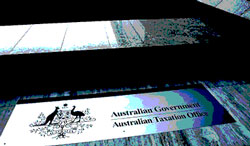Canon Australia Pty Ltd total revenue fell from $670 million in 2013 to $658 million in 2014, with a profit before tax of $1.16 million boosted by income tax benefits of $6.61 million, resulting in an after tax profit of $7.77 million.
 That is, around six out of every seven dollars of Canon’s bottom line profit resulted from tax benefits rather than income from operations.
That is, around six out of every seven dollars of Canon’s bottom line profit resulted from tax benefits rather than income from operations.
Canon’s financial year runs from January to December. These figures are based on an annual report lodged with ASIC this month.
Over the past four years (2011-2014), Canon Australia has had sales of around $2.8 billion, with profits after tax of just $48 million. But almost $13 million of after tax profits have actually been tax benefits from the ATO. In other words, tax benefits account for over one in four dollars of Canon’s income between 2011 to 2014. Canon Australia has contributed income tax, rather than received a tax benefit, in only one of those four years; last year it paid $561,000 on a profit of $4.1 million.
As noted last October when PhotoCounter covered Canon Austraia’s 2013 financials, the issue becomes more relevant to the photo industry now that Canon competes as an online retailer of photographic goods. It also operates at a retail level in photo printing services via its PhotoPico business, where it competes against other photo services businesses. Sun Studios competes against professional resellers. (Although it needs to be emphasised that Sun Studios is a separate business within the Canon consolidated group.)
Being able to minimise tax payments delivers Canon’s retail businesses an added advantage beyond sourcing its products at landed cost, economies of scale and the harvesting of Canon authorised retailers’ customer contact details. Most competing businesses, many of which are ‘mum and dad’ operations, would not have the accountancy resources to minimise company tax below the Australian rate of 30 cents in the dollar.
Canon’s accountancy fees to Ernst & Young doubled between 2013 and 2014, up from $224,000 to $452,000. Money well spent!
Another insight from Canon’s 2014 annual report is that its Cost of Sales (essentially landed cost of goods sold) was $$433 million from which it made a gross profit of $225 million, which gives some indication of the average wholesale margin passed on to retailer customers.
Photo Counter approached Canon via its PR agency, Ogilvy, earlier this week to seek further insight into the issue. At time of publication there was no response.
COMMENT: A pubic company’s primary obligation is to maximise shareholder value. If dumb Australian tax rules allow benefits such as these, it could be argued that Canon has a duty to its shareholders to use them. But if we take the level playing field metaphor and run with it when looking at Canon’s retail competition with its customers, it’s as if Canon is not only running downhill, but getting a free kick at the start of the game in terms of landed cost prices, and another one at the end of the game in terms of these tax advantages. It’s a funny old world!





Be First to Comment